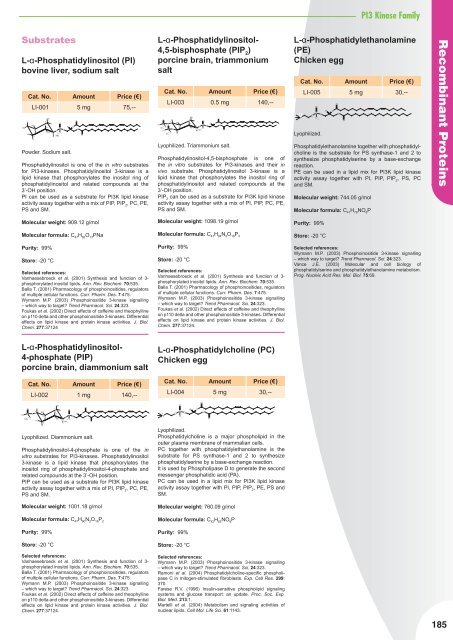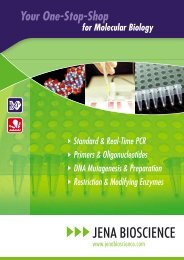Nucleotide Analogs - Jena Bioscience
Nucleotide Analogs - Jena Bioscience
Nucleotide Analogs - Jena Bioscience
You also want an ePaper? Increase the reach of your titles
YUMPU automatically turns print PDFs into web optimized ePapers that Google loves.
Substrates<br />
L-α-Phosphatidylinositol (PI)<br />
bovine liver, sodium salt<br />
Cat. No. Amount Price (€)<br />
LI-001 5 mg 75,--<br />
H<br />
4<br />
HO<br />
HO<br />
3<br />
H<br />
HO<br />
5<br />
H<br />
OH<br />
2<br />
H<br />
H<br />
6<br />
OH<br />
1<br />
H<br />
O<br />
O<br />
H O<br />
P<br />
O<br />
O<br />
O<br />
O<br />
+ -<br />
Na<br />
O<br />
Powder. Sodium salt.<br />
Phosphatidylinositol is one of the in vitro substrates<br />
for PI3-kinases. Phosphatidylinositol 3-kinase is a<br />
lipid kinase that phosphorylates the inositol ring of<br />
phosphatidylinositol and related compounds at the<br />
3’-OH position.<br />
PI can be used as a substrate for PI3K lipid kinase<br />
activity assay together with a mix of PIP, PIP 2 , PC, PE,<br />
PS and SM.<br />
Molecular weight: 909.12 g/mol<br />
Molecular formula: C 47 H 82 O 13 PNa<br />
Purity: 99%<br />
Store: -20 °C<br />
Selected references:<br />
Vanhaesebroeck et al. (2001) Synthesis and function of 3phosphorylated<br />
inositol lipids. Ann. Rev. Biochem. 70:535.<br />
Balla T. (2001) Pharmacology of phosphoinositides, regulators<br />
of multiple cellular functions. Curr. Pharm. Des. 7:475.<br />
Wymann M.P. (2003) Phosphoinositide 3-kinase signalling<br />
– which way to target? Trend Pharmacol. Sci. 24:323.<br />
Foukas et al. (2002) Direct effects of caffeine and theophylline<br />
on p110 delta and other phosphoinositide 3-kinases. Differential<br />
effects on lipid kinase and protein kinase activities. J. Biol.<br />
Chem. 277:37124<br />
L-α-Phosphatidylinositol-<br />
4-phosphate (PIP)<br />
porcine brain, diammonium salt<br />
Cat. No. Amount Price (€)<br />
LI-002 1 mg 140,--<br />
O H<br />
4<br />
HO<br />
P O<br />
HO<br />
3<br />
+ O<br />
NH - 4<br />
H<br />
HO<br />
5<br />
H<br />
OH<br />
2<br />
O<br />
H O<br />
H<br />
6<br />
H<br />
P<br />
O<br />
O<br />
OH<br />
O<br />
1 + -<br />
NH4 H<br />
O<br />
O<br />
O<br />
Lyophilized. Diammonium salt.<br />
Phosphatidylinositol-4-phosphate is one of the in<br />
vitro substrates for PI3-kinases. Phosphatidylinositol<br />
3-kinase is a lipid kinase that phosphorylates the<br />
inositol ring of phosphatidylinositol-4-phosphate and<br />
related compounds at the 3’-OH position.<br />
PIP can be used as a substrate for PI3K lipid kinase<br />
activity assay together with a mix of PI, PIP 2 , PC, PE,<br />
PS and SM.<br />
Molecular weight: 1001.18 g/mol<br />
Molecular formula: C 47 H 90 N 2 O 16 P 2<br />
Purity: 99%<br />
Store: -20 °C<br />
Selected references:<br />
Vanhaesebroeck et al. (2001) Synthesis and function of 3phosphorylated<br />
inositol lipids. Ann. Rev. Biochem. 70:535.<br />
Balla T. (2001) Pharmacology of phosphoinositides, regulators<br />
of multiple cellular functions. Curr. Pharm. Des. 7:475.<br />
Wymann M.P. (2003) Phosphoinositide 3-kinase signalling<br />
– which way to target? Trend Pharmacol. Sci. 24:323.<br />
Foukas et al. (2002) Direct effects of caffeine and theophylline<br />
on p110 delta and other phosphoinositide 3-kinases. Differential<br />
effects on lipid kinase and protein kinase activities. J. Biol.<br />
Chem. 277:37124.<br />
L-α-Phosphatidylinositol-<br />
4,5-bisphosphate (PIP 2 )<br />
porcine brain, triammonium<br />
salt<br />
HO<br />
Cat. No. Amount Price (€)<br />
LI-003 0.5 mg 140,--<br />
O H<br />
4<br />
HO<br />
P O<br />
O<br />
3<br />
+ O<br />
NH - 4<br />
H<br />
P O<br />
HO<br />
5<br />
+ O<br />
- H<br />
NH4 OH<br />
2<br />
O<br />
H O<br />
H<br />
6<br />
H O<br />
P<br />
O<br />
O<br />
O<br />
OH<br />
O<br />
1 + -<br />
NH O<br />
4 H<br />
Lyophilized. Triammonium salt.<br />
Phosphatidylinositol-4,5-bisphosphate is one of<br />
the in vitro substrates for PI3-kinases and their in<br />
vivo substrate. Phosphatidylinositol 3-kinase is a<br />
lipid kinase that phosphorylates the inositol ring of<br />
phosphatidylinositol and related compounds at the<br />
3‘-OH position.<br />
PIP 2 can be used as a substrate for PI3K lipid kinase<br />
activity assay together with a mix of PI, PIP, PC, PE,<br />
PS and SM.<br />
Molecular weight: 1098.19 g/mol<br />
Molecular formula: C 47 H 94 N 3 O 19 P 3<br />
Purity: 99%<br />
Store: -20 °C<br />
Selected references:<br />
Vanhaesebroeck et al. (2001) Synthesis and function of 3phosphorylated<br />
inositol lipids. Ann. Rev. Biochem. 70:535.<br />
Balla T. (2001) Pharmacology of phosphoinositides, regulators<br />
of multiple cellular functions. Curr. Pharm. Des. 7:475.<br />
Wymann M.P. (2003) Phosphoinositide 3-kinase signalling<br />
– which way to target? Trend Pharmacol. Sci. 24:323.<br />
Foukas et al. (2002) Direct effects of caffeine and theophylline<br />
on p110 delta and other phosphoinositide 3-kinases. Differential<br />
effects on lipid kinase and protein kinase activities. J. Biol.<br />
Chem. 277:37124.<br />
L-α-Phosphatidylcholine (PC)<br />
Chicken egg<br />
Cat. No. Amount Price (€)<br />
LI-004 5 mg 30,--<br />
+<br />
N<br />
O<br />
O<br />
H O<br />
P<br />
O<br />
O<br />
O<br />
O<br />
-<br />
O<br />
Lyophilized.<br />
Phosphatidylcholine is a major phospholipid in the<br />
outer plasma membrane of mammalian cells.<br />
PC together with phosphatidylethanolamine is the<br />
substrate for PS synthase-1 and 2 to synthesize<br />
phosphatidylserine by a base-exchange reaction.<br />
It is used by Phospholipase D to generate the second<br />
messenger phosphatidic acid (PA).<br />
PC can be used in a lipid mix for PI3K lipid kinase<br />
activity assay together with PI, PIP, PIP 2 , PE, PS and<br />
SM.<br />
Molecular weight: 760.09 g/mol<br />
Molecular formula: C 42 H 82 NO 8 P<br />
Purity: 99%<br />
Store: -20 °C<br />
Selected references:<br />
Wymann M.P. (2003) Phosphoinositide 3-kinase signalling<br />
– which way to target? Trend Pharmacol. Sci. 24:323.<br />
Ramoni et al. (2004) Phosphatidylcholine-specifi c phospholipase<br />
C in mitogen-stimulated fi broblasts. Exp. Cell Res. 299:<br />
370.<br />
Farese R.V. (1996) Insulin-sensitive phospholipid signaling<br />
systems and glucose transport: an update. Proc. Soc. Exp.<br />
Biol. Med. 213:1.<br />
Martelli et al. (2004) Metabolism and signaling activities of<br />
nuclear lipids. Cell Mol. Life Sci. 61:1143.<br />
PI3 Kinase Family<br />
L-α-Phosphatidylethanolamine<br />
(PE)<br />
Chicken egg<br />
Cat. No. Amount Price (€)<br />
LI-005 5 mg 30,--<br />
+<br />
N<br />
O<br />
H O<br />
P<br />
O<br />
O<br />
O<br />
-<br />
Lyophilized.<br />
O<br />
O<br />
O<br />
Phosphatidylethanolamine together with phosphatidylcholine<br />
is the substrate for PS synthase-1 and 2 to<br />
synthesize phosphatidylserine by a base-exchange<br />
reaction.<br />
PE can be used in a lipid mix for PI3K lipid kinase<br />
activity assay together with PI, PIP, PIP 2 , PS, PC<br />
and SM.<br />
Molecular weight: 744.05 g/mol<br />
Molecular formula: C 41 H 78 NO 8 P<br />
Purity: 99%<br />
Store: -20 °C<br />
Selected references:<br />
Wymann M.P. (2003) Phosphoinositide 3-kinase signalling<br />
– which way to target? Trend Pharmacol. Sci. 24:323.<br />
Vance J.E. (2003) Molecular and cell biology of<br />
phosphatidylserine and phosphatidylethanolamine metabolism.<br />
Prog. Nucleic Acid Res. Mol. Biol. 75:69.<br />
Recombinant Proteins<br />
185



